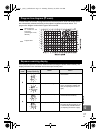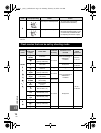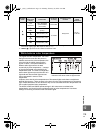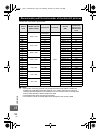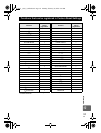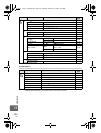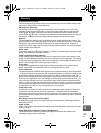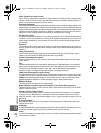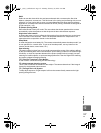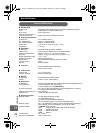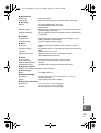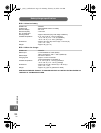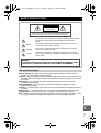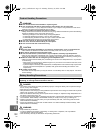
125
EN
13
Information
A (Aperture Priority) Mode
You set the aperture yourself and the camera automatically varies the shutter speed so that
the picture is taken with the correct exposure.
AE (Automatic Exposure)
The camera’s built-in exposure meter automatically sets the exposure. The 3 AE modes
available on this camera are P mode, in which the camera selects both the aperture and
shutter speed, A mode, in which the user selects the aperture and the camera sets the
shutter speed, and S mode, in which the user selects the shutter speed and the camera sets
the aperture. In M mode, the user selects both the aperture and the shutter speed.
Aperture
The adjustable lens opening which controls the amount of light that enters the camera. The
larger the aperture, the shorter the depth of field and the fuzzier the background. The smaller
the aperture, the greater the depth of field and the sharper the background. Aperture is
measured in f/stops. Larger aperture values indicate smaller apertures, and smaller aperture
values indicate larger apertures.
AUTO mode
Program AE mode (see “P (Program) Mode”). In addition, this mode features automatic flash
pop up when shooting in low-light conditions.
Center weighted averaging metering
A light metering mode or technique that uses an average of the center and periphery of the
image area but is biased toward the information at the center of the image area. This method
is best used when the brightness of the center and periphery of the image area does not vary
greatly. See also digital ESP metering and spot metering.
Color space
A model that describes colors using more than three coordinates. Color spaces such as
sRGB, Adobe RGB are occasionally used for encoding/reproducing colors.
Color temperature
The spectral balance of different white light sources is rated numerically by color temperature
- a concept of theoretical physics that, with incandescent lighting, corresponds roughly to the
absolute lamp filament temperature, expressed on the Kelvin (K) temperature scale. The
higher the color temperature, the richer the light in bluish tones and the poorer in reddish; the
lower the color temperature, the richer the light in reddish tones and the poorer in bluish. You
may encounter difficulties with color reproduction when shooting indoors under fluorescent
lighting, or where sunlight and fluorescent lighting are both present. Your camera is provided
with a white balance adjustment feature that you can use to compensate for the odd effects
of combinations of color you may occasionally see in your pictures.
Compression rate
Compression is a method of reducing file size by abbreviating some contents of data, and
compression rate denotes the amount of compression. The actual effect of the selected
compression rate could vary with the content of the image. The numbers for the compression
rate selected with this camera provide only a general scale for reference and are not precise
measurements.
DCF (Design rule for Camera File system)
A standard for image files by the Japan Electronics and Information Technology Industries
Association (JEITA).
Depth of Field
Depth of Field refers to the distance from the nearest to the furthest point of perceived “sharp”
focus in a picture.
Digital ESP (Electro-Selective Pattern) Light Metering
This determines the exposure by splitting the image into 49 areas and metering and
calculating the light levels in each area.
Glossary
s0016_e_00_0_unified.book Page 125 Monday, February 18, 2008 2:43 PM



